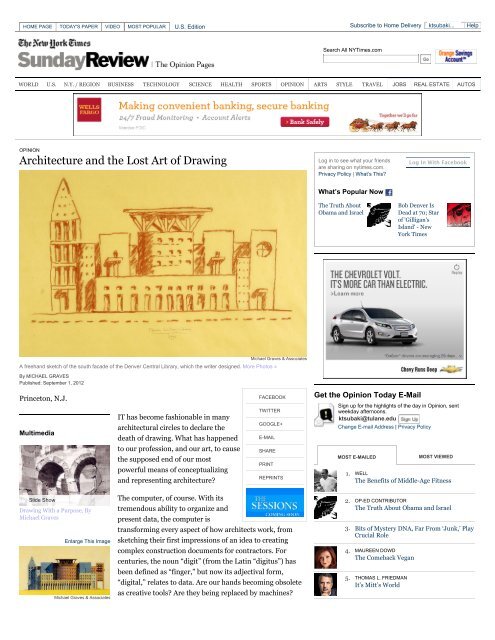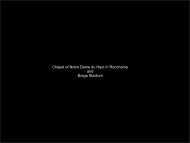Architecture and the Lost Art of Drawing - NYTimes.com - KT Studio
Architecture and the Lost Art of Drawing - NYTimes.com - KT Studio
Architecture and the Lost Art of Drawing - NYTimes.com - KT Studio
You also want an ePaper? Increase the reach of your titles
YUMPU automatically turns print PDFs into web optimized ePapers that Google loves.
HOME PAGE TODAY'S PAPER VIDEO MOST POPULAR<br />
U.S. Edition<br />
Subscribe to Home Delivery<br />
ktsubaki...<br />
Help<br />
Search All <strong>NYTimes</strong>.<strong>com</strong><br />
WORLD U.S. N.Y. / REGION BUSINESS TECHNOLOGY SCIENCE HEALTH SPORTS OPINION ARTS STYLE TRAVEL JOBS REAL ESTATE AUTOS<br />
OPINION<br />
<strong>Architecture</strong> <strong>and</strong> <strong>the</strong> <strong>Lost</strong> <strong>Art</strong> <strong>of</strong> <strong>Drawing</strong><br />
Log in to see what your friends<br />
are sharing on nytimes.<strong>com</strong>.<br />
Privacy Policy | What’s This?<br />
Log In With Facebook<br />
What’s Popular Now<br />
The Truth About<br />
Obama <strong>and</strong> Israel<br />
Bob Denver Is<br />
Dead at 70; Star<br />
<strong>of</strong> 'Gilligan's<br />
Isl<strong>and</strong>' - New<br />
York Times<br />
A freeh<strong>and</strong> sketch <strong>of</strong> <strong>the</strong> south facade <strong>of</strong> <strong>the</strong> Denver Central Library, which <strong>the</strong> writer designed. More Photos »<br />
By MICHAEL GRAVES<br />
Published: September 1, 2012<br />
Michael Graves & Associates<br />
Princeton, N.J.<br />
Multimedia<br />
IT has be<strong>com</strong>e fashionable in many<br />
architectural circles to declare <strong>the</strong><br />
death <strong>of</strong> drawing. What has happened<br />
FACEBOOK<br />
TWITTER<br />
GOOGLE+<br />
E-MAIL<br />
Get <strong>the</strong> Opinion Today E-Mail<br />
Sign up for <strong>the</strong> highlights <strong>of</strong> <strong>the</strong> day in Opinion, sent<br />
weekday afternoons.<br />
ktsubaki@tulane.edu<br />
Change E-mail Address | Privacy Policy<br />
to our pr<strong>of</strong>ession, <strong>and</strong> our art, to cause<br />
<strong>the</strong> supposed end <strong>of</strong> our most<br />
powerful means <strong>of</strong> conceptualizing<br />
<strong>and</strong> representing architecture?<br />
SHARE<br />
PRINT<br />
REPRINTS<br />
MOST E-MAILED<br />
MOST VIEWED<br />
1. WELL<br />
The Benefits <strong>of</strong> Middle-Age Fitness<br />
Slide Show<br />
<strong>Drawing</strong> With a Purpose, By<br />
Michael Graves<br />
Enlarge This Image<br />
Michael Graves & Associates<br />
The <strong>com</strong>puter, <strong>of</strong> course. With its<br />
tremendous ability to organize <strong>and</strong><br />
present data, <strong>the</strong> <strong>com</strong>puter is<br />
transforming every aspect <strong>of</strong> how architects work, from<br />
sketching <strong>the</strong>ir first impressions <strong>of</strong> an idea to creating<br />
<strong>com</strong>plex construction documents for contractors. For<br />
centuries, <strong>the</strong> noun “digit” (from <strong>the</strong> Latin “digitus”) has<br />
been defined as “finger,” but now its adjectival form,<br />
“digital,” relates to data. Are our h<strong>and</strong>s be<strong>com</strong>ing obsolete<br />
as creative tools? Are <strong>the</strong>y being replaced by machines?<br />
2. OP-ED CONTRIBUTOR<br />
The Truth About Obama <strong>and</strong> Israel<br />
3. Bits <strong>of</strong> Mystery DNA, Far From ‘Junk,’ Play<br />
Crucial Role<br />
4. MAUREEN DOWD<br />
The Comeback Vegan<br />
5. THOMAS L. FRIEDMAN<br />
It’s Mitt’s World
A drafted drawing <strong>of</strong> <strong>the</strong> south facade<br />
<strong>of</strong> <strong>the</strong> Denver Central Library. More<br />
Photos »<br />
And where does that leave <strong>the</strong> architectural creative<br />
process?<br />
6. WELL<br />
Rare Infection Prompts Neti Pot Warning<br />
Today architects typically use <strong>com</strong>puter-aided design<br />
s<strong>of</strong>tware with names like AutoCAD <strong>and</strong> Revit, a tool for “building information modeling.”<br />
Buildings are no longer just designed visually <strong>and</strong> spatially; <strong>the</strong>y are “<strong>com</strong>puted” via<br />
interconnected databases.<br />
I’ve been practicing architecture since 1964, <strong>and</strong> my <strong>of</strong>fice is not immune. Like most<br />
architects, we routinely use <strong>the</strong>se <strong>and</strong> o<strong>the</strong>r s<strong>of</strong>tware programs, especially for construction<br />
documents, but also for developing designs <strong>and</strong> making presentations. There’s nothing<br />
inherently problematic about that, as long as it’s not just that.<br />
<strong>Architecture</strong> cannot divorce itself from drawing, no matter how impressive <strong>the</strong> technology<br />
gets. <strong>Drawing</strong>s are not just end products: <strong>the</strong>y are part <strong>of</strong> <strong>the</strong> thought process <strong>of</strong><br />
architectural design. <strong>Drawing</strong>s express <strong>the</strong> interaction <strong>of</strong> our minds, eyes <strong>and</strong> h<strong>and</strong>s. This<br />
last statement is absolutely crucial to <strong>the</strong> difference between those who draw to<br />
conceptualize architecture <strong>and</strong> those who use <strong>the</strong> <strong>com</strong>puter.<br />
Go to Complete List »<br />
7. Prolonged CPR Holds Benefits, a Study<br />
Shows<br />
8. FALL RESTAURANT PREVIEW<br />
What Restaurants Know (About You)<br />
9. ECONOMIC SCENE<br />
G.O.P. Shift Moves Center Far to Right<br />
10. FALL RESTAURANT PREVIEW | HOW TO COOK<br />
EVERYTHING<br />
Sometimes Formica Beats White<br />
Tablecloths<br />
Show My Re<strong>com</strong>mendations<br />
Of course, in some sense drawing can’t be dead: <strong>the</strong>re is a vast market for <strong>the</strong> original<br />
work <strong>of</strong> respected architects. I have had several one-man shows in galleries <strong>and</strong> museums<br />
in New York <strong>and</strong> elsewhere, <strong>and</strong> my drawings can be found in <strong>the</strong> collections <strong>of</strong> <strong>the</strong><br />
Metropolitan Museum <strong>of</strong> <strong>Art</strong>, <strong>the</strong> Museum <strong>of</strong> Modern <strong>Art</strong> <strong>and</strong> <strong>the</strong> Cooper-Hewitt.<br />
But can <strong>the</strong> value <strong>of</strong> drawings be simply that <strong>of</strong> a collector’s artifact or a pretty picture? No.<br />
I have a real purpose in making each drawing, ei<strong>the</strong>r to remember something or to study<br />
something. Each one is part <strong>of</strong> a process <strong>and</strong> not an end in itself. I’m personally fascinated<br />
not just by what architects choose to draw but also by what <strong>the</strong>y choose not to draw.<br />
For decades I have argued that architectural drawing can be divided into three types,<br />
which I call <strong>the</strong> “referential sketch,” <strong>the</strong> “preparatory study” <strong>and</strong> <strong>the</strong> “definitive drawing.”<br />
The definitive drawing, <strong>the</strong> final <strong>and</strong> most developed <strong>of</strong> <strong>the</strong> three, is almost universally<br />
produced on <strong>the</strong> <strong>com</strong>puter nowadays, <strong>and</strong> that is appropriate. But what about <strong>the</strong> o<strong>the</strong>r<br />
two? What is <strong>the</strong>ir value in <strong>the</strong> creative process? What can <strong>the</strong>y teach us?<br />
The Competitor in Chief<br />
ALSO IN VIDEO »<br />
A conversation with <strong>the</strong> keynote speaker<br />
Videos from <strong>the</strong> Republican National Convention<br />
ADVERTISEMENTS<br />
The referential sketch serves as a visual diary, a record <strong>of</strong> an architect’s discovery. It can be<br />
as simple as a shorth<strong>and</strong> notation <strong>of</strong> a design concept or can describe details <strong>of</strong> a larger<br />
<strong>com</strong>position. It might not even be a drawing that relates to a building or any time in<br />
history. It’s not likely to represent “reality,” but ra<strong>the</strong>r to capture an idea.<br />
These sketches are thus inherently fragmentary <strong>and</strong> selective. When I draw something, I<br />
remember it. The drawing is a reminder <strong>of</strong> <strong>the</strong> idea that caused me to record it in <strong>the</strong> first<br />
place. That visceral connection, that thought process, cannot be replicated by a <strong>com</strong>puter.<br />
The second type <strong>of</strong> drawing, <strong>the</strong> preparatory study, is typically part <strong>of</strong> a progression <strong>of</strong><br />
drawings that elaborate a design. Like <strong>the</strong> referential sketch, it may not reflect a linear<br />
process. (I find <strong>com</strong>puter-aided design much more linear.) I personally like to draw on<br />
translucent yellow tracing paper, which allows me to layer one drawing on top <strong>of</strong> ano<strong>the</strong>r,<br />
building on what I’ve drawn before <strong>and</strong>, again, creating a personal, emotional connection<br />
with <strong>the</strong> work.<br />
With both <strong>of</strong> <strong>the</strong>se types <strong>of</strong> drawings, <strong>the</strong>re is a certain joy in <strong>the</strong>ir creation, which <strong>com</strong>es<br />
from <strong>the</strong> interaction between <strong>the</strong> mind <strong>and</strong> <strong>the</strong> h<strong>and</strong>. Our physical <strong>and</strong> mental interactions<br />
with drawings are formative acts. In a h<strong>and</strong>made drawing, whe<strong>the</strong>r on an electronic tablet<br />
or on paper, <strong>the</strong>re are intonations, traces <strong>of</strong> intentions <strong>and</strong> speculation. This is not unlike<br />
<strong>the</strong> way a musician might intone a note or how a riff in jazz would be understood<br />
subliminally <strong>and</strong> put a smile on your face.<br />
I find this quite different from today’s “parametric design,” which allows <strong>the</strong> <strong>com</strong>puter to<br />
Ads by Google<br />
3 Early Signs <strong>of</strong> Dementia<br />
Doctor: Know These 3 Warning Signs<br />
what's this?
generate form from a set <strong>of</strong> instructions, sometimes resulting in so-called blob<br />
architecture. The designs are <strong>com</strong>plex <strong>and</strong> interesting in <strong>the</strong>ir own way, but <strong>the</strong>y lack <strong>the</strong><br />
emotional content <strong>of</strong> a design derived from h<strong>and</strong>.<br />
You're About to Suffer Dementia<br />
www.w3.newsmax.<strong>com</strong><br />
Years ago I was sitting in a ra<strong>the</strong>r boring faculty meeting at Princeton. To pass <strong>the</strong> time, I<br />
pulled out my pad to start drawing a plan, probably <strong>of</strong> some building I was designing. An<br />
equally bored colleague was watching me, amused. I came to a point <strong>of</strong> indecision <strong>and</strong><br />
passed <strong>the</strong> pad to him. He added a few lines <strong>and</strong> passed it back.<br />
The game was on. Back <strong>and</strong> forth we went, drawing five lines each, <strong>the</strong>n four <strong>and</strong> so on.<br />
While we didn’t speak, we were engaged in a dialogue over this plan <strong>and</strong> we understood<br />
each o<strong>the</strong>r perfectly. I suppose that you could have a debate like that with words, but it<br />
would have been entirely different. Our game was not about winners or losers, but about a<br />
shared language. We had a genuine love for making this drawing. There was an insistence,<br />
by <strong>the</strong> act <strong>of</strong> drawing, that <strong>the</strong> <strong>com</strong>position would stay open, that <strong>the</strong> speculation would<br />
stay “wet” in <strong>the</strong> sense <strong>of</strong> a painting. Our plan was without scale <strong>and</strong> we could as easily<br />
have been drawing a domestic building as a portion <strong>of</strong> a city. It was <strong>the</strong> act <strong>of</strong> drawing that<br />
allowed us to speculate.<br />
As I work with my <strong>com</strong>puter-savvy students <strong>and</strong> staff today, I notice that something is lost<br />
when <strong>the</strong>y draw only on <strong>the</strong> <strong>com</strong>puter. It is analogous to hearing <strong>the</strong> words <strong>of</strong> a novel read<br />
aloud, when reading <strong>the</strong>m on paper allows us to daydream a little, to make associations<br />
beyond <strong>the</strong> literal sentences on <strong>the</strong> page. Similarly, drawing by h<strong>and</strong> stimulates <strong>the</strong><br />
imagination <strong>and</strong> allows us to speculate about ideas, a good sign that we’re truly alive.<br />
Michael Graves is an architect <strong>and</strong> an emeritus pr<strong>of</strong>essor at Princeton.<br />
A version <strong>of</strong> this op-ed appeared in print on September 2, 2012, on page SR5 <strong>of</strong> <strong>the</strong> New York edition with <strong>the</strong> headline:<br />
<strong>Architecture</strong> <strong>and</strong> <strong>the</strong> <strong>Lost</strong> <strong>Art</strong> <strong>of</strong> <strong>Drawing</strong>.<br />
FACEBOOK TWITTER GOOGLE+ E-MAIL SHARE<br />
Get 50% Off The New York Times & Free All Digital Access.<br />
Get Free E-mail Alerts on These Topics<br />
<strong>Architecture</strong><br />
Computers <strong>and</strong> <strong>the</strong> Internet<br />
<strong>Art</strong><br />
Ads by Google<br />
what's this?<br />
Master <strong>of</strong> <strong>Architecture</strong><br />
Online <strong>Architecture</strong> Degree Program<br />
Accredited by NAAB - Apply Now!<br />
www.ltu.edu<br />
INSIDE NYTIMES.COM<br />
N.Y. / REGION »<br />
DINING & WINE »<br />
OPINION »<br />
MOVIES »<br />
OPINION »<br />
SPORTS »<br />
Legality Is Questioned Over<br />
Sometimes Formica Beats<br />
Op-Ed: Is <strong>the</strong><br />
Energy Boom a<br />
Mirage?<br />
The oil <strong>and</strong> natural gas<br />
boom might distract us<br />
from <strong>the</strong> urgent<br />
challenge <strong>of</strong> climate<br />
change.<br />
A Star Swerves a Bit; He’s<br />
Should <strong>the</strong><br />
Spouse Give a<br />
Speech?<br />
In Room for Debate:<br />
Once, <strong>the</strong> nominee’s<br />
spouse was expected to<br />
smile <strong>and</strong> wave. Now a<br />
convention speech is de<br />
A Chance to Buy a Piece <strong>of</strong>
Taxi-Hailing App White Tablecloths Fine With That rigueur. <strong>the</strong> Tennis Action<br />
Home World U.S. N.Y. / Region Business Technology Science Health Sports Opinion <strong>Art</strong>s Style Travel Jobs Real Estate Autos Site Map<br />
© 2012 The New York Times Company Privacy Your Ad Choices Terms <strong>of</strong> Service Terms <strong>of</strong> Sale Corrections RSS Help Contact Us Work With Us Advertise<br />
MORE IN OPINION (1 OF 25 ARTICLES)<br />
Op-Ed Contributor: Learning as<br />
Freedom<br />
Read More »




